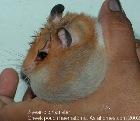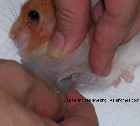"I have a 2-year-old hamster with a large swelling under the neck after he
had been boarded with a friend for three weeks while I was on holiday," said
Mrs Mazlan over the phone. "What shall I do?"
"I don't know. I have not examined the hamster and am unable to advise you
over the phone," I said. I dislike phone consultations but these are part
and parcel of every service provider. If the advice given is wrong, the
animal may die and the vet gets cursed.
 "It is extremely difficult to diagnose over the telephone." I said. "It is
best to see your veterinarian. One of the common conditions will be an
abscess which is a skin swelling with lots of pus. Is it a hard or soft
swelling" "It is extremely difficult to diagnose over the telephone." I said. "It is
best to see your veterinarian. One of the common conditions will be an
abscess which is a skin swelling with lots of pus. Is it a hard or soft
swelling"
"It is a soft swelling and is very big." said Mrs Mazlan. It would
be
an abscess if it was soft. An abscess under the neck could be caused by this
hamster being bitten by another hamster while being looked after by a
friend, I thought.
"As the hamster has not been eating much and it is nearing the end of its
life span, any anaesthesia to remove the blood or pus from the haematoma or abscess will be
risky," I advised. "It may just die during or after anaesthesia. Do you want
to wait a few days to see if the lump will reduce?" This risk is great
and must be communicated to the owner to prevent misunderstanding. The
hamster did have a swelling in its tummy sometime ago and it had burst and
the hamster was back to normal.
Mrs Mazlan thought hamsters live longer than two years. This hamster
would be around fifty human equivalent years old. It looked fit. The
swelling was unbelievably big, as big as its head. It was not soft at all
but it was not hard as a rock. It was so big that it hung down, as if it was
a neck swelling. It was more a cheek pouch swelling weighed down by its size
and had extended into the neck area. Therefore Mrs Mazlan said it was a neck swelling.
 The hamster's natural behaviour is to stuff as much food as possible into
its cheek pouches and then store them in a corner of the cage. Some do stuff
the wood shavings used as bedding too. The hamster's natural behaviour is to stuff as much food as possible into
its cheek pouches and then store them in a corner of the cage. Some do stuff
the wood shavings used as bedding too.
Sunflower seeds are a common part of the hamster's feed all over the world
and this hamster could have stored more than normal as it might be feeling
insecure in a new surrounding away from Mrs Mazlan and her three lovely
daughters.
Some sharp food might have punctured the pouch lining and caused an
infection which developed into a large mass of over 4 cm long in three
weeks. This assumed that the growth was not a tumour.
Besides storing food, the hamster can puff up its cheek pouches to a large
swelling to frighten off enemies. In this case, it was definitely a
big bean-shaped lump inside the left cheek pouch. A lump which had developed
during the boarding period. It was living alone and therefore could not be
bitten by another hamster but Mrs Mazlan was not sure about this. What was
this lobulated dark red lump which looked like a tumour known as a
haemangiosarcoma? Was it a haematoma or blood clot? Was it a
blood-related tumour? One daughter had seen some bleeding from inside the
mouth but she told me that after the surgery.
The hamster was put under gas anaesthesia inside a container packed with
cotton wool and anaesthetic. I needed a sufficient amount of pain
relief to remove the lump and stitch up the skin incision. It must not be
too much such that the hamster's heart stopped beating. It must not be
insufficient as
the hamster would wake up in the middle of stitching or removal of the large
mass.
After 2 minutes of sniffing the anaesthesia, I took out the Syrian hamster
and placed it on the table for surgery. It looked dead and lifeless. It was
difficult to see whether its eye pupils were dilated as it had small eyes.
The eyes popped out and therefore it was not easy to check the blink effect
which could be done in a dog under anaesthesia. If the eyes blinked when the
eyelids were touched, the anaesthesia would be insufficient. If the eye pupils
were
dilated, the anaesthesia would be very deep. If its chest moved, it was still alive
and breathing. If the tongue was purplish, there was a danger of death
from lack of oxygen. None of this could be easily observed in a small
hamster.
Was it dead? A dead hamster always sully a veterinarian's reputation no
matter how informed clients had been. The youngest daughter, around
ten years old cried as she saw the limp body from outside the operating
room. It was best not to observe the surgery, so I asked them to go
somewhere. My reputation was on the line.
I
incised the skin with a scalpel expecting thick cheesy pus to come out as I
expected an abscess. The operation should be done in less than 60
minutes as the hamster was under minimal anaesthesia.
However, there appeared a glistening membrane covering this reddish lump
like a capsule. There were two large "veins" attached to two poles of the
bean shaped lump. I clamped the "veins" although they would not be real
blood vessels.
The lump was shelled out from the skin. The incision was more than 2 cm and
I quickly stitched the big wound using the hair-like suture 5/0. I
used fine sutures so that the hamster would not feel it.
I expected the hamster would groom excessively to remove the stitches if fine
ones were not used. There was a lot of bleeding in this operation. The lump had a jelly-like
golden yellow core when I cut it. This lump was most probably a
haemagiosarcoma
or a blood
tumour of the cheek pouch. One of the big veins must have been punctured by the sharp
seeds as this hamster had a habit of over-stuffing its pouch. It could have
stuffed more when it was insecure in a strange place for three weeks. This
was human speculation. Do hamsters feel insecure like people?
I gave it an antibiotic-dextrose injection as I did not expect it to take oral
medication well. The hamster survived for the next twenty four hours. The next seven days would be important. If it survived, it would lead a new
lease of life much loved by the three sisters and not be fed any sharp
seeds.
This case showed that the telephone diagnosis was not satisfactory as the
"big and soft neck" swelling was gigantic relative to the hamster's weight
and it was not soft. Over the phone, I thought it was an abscess. In
reality, it was a large cheek pouch blood-type tumour. The hamster was
still strong enough to undergo anaesthesia and therefore its chances of
survival were excellent.
If there was a wait of another two weeks, it would be very weak to take the
anaesthesia.
The big lump on the cheek pouch recurred a few weeks later, indicating that
this was a tumour. The owner did not bring the hamster for further
examination. As the hamster was old, the tumour of the cheek pouch would
have re-grown since it was malignant and it would be impossible to remove
all cancerous cells. No histopathology was done as it would cost the owner
more money.
The average hamster lives 18 - 24 months and this hamster
was nearing 24 months of age. It could be considered old.
Note:
The pictures above are that of the golden or Syrian hamster, Mesocrietus
auratus, is a small, short-tailed, stocky rodent. The Syrian hamster have
two well-developed cheek pouches positioned below the skin on either side of
the neck and head. The two pouches are internal muscular sacs, which extend
back quite some distance, like a corridor on the inside of each cheek.
The purpose of these internal pouches is to carry food and bedding materials
which can be vast, since each pouch measures when empty approximately 30
40mm in length and 3 9mm in width. A female can even hide her young inside
her pouches if she senses danger, which can be very dangerous to her young
since they could suffocate.
The retractor muscle is not sufficiently powerful enough to remove items
from the pouches. A hamster will use their hands to empty their pouches by
manipulating the cheeks with a massaging action and the use of its tongue.
The dwarf hamster has smaller cheek pouches.
More information:
Hamsters are nocturnal but do have short periods of activity in the day.
They are known for their cheek pouches where they store food for transport
for storage in their burrows. These cheek pouches are quite large and can
extend to their shoulders. They use their front legs to move food out of the
pouches by using a forward pushing motion. There are several color
variations and a long-haired hamster known as teddy bears.
Hamsters are very healthy
animals. Problems can arise when injured in a fight, from illnesses due to
dirty cages (skin and respiratory), wet tail which is diarrhea, and
malocclusion due to improper teeth alignment which can lead to malnutrition
and death.
Hamsters use their cheek pouch to collect and transport food and nesting
material from one place to another. When emptying their cheek pouch, they
will use their forepaws to push the contents from the back of the cheek
pouch forwards. This is especially important in the wild, as the cheek pouch
enables a hamster to hoard and store food in winter, and when food supplies
are low.
The skin lining a hamster's cheek pouch is dry and tough, and digestive
processes such as salivating on the food do not occur in the cheek pouch,
ensuring that the food stored in the pouch remains dry and fresh. The
bristly texture of the cheek pouch's skin also prevents food from falling
out into their mouth.
|
 TOA
PAYOH VETS
TOA
PAYOH VETS TOA
PAYOH VETS
TOA
PAYOH VETS